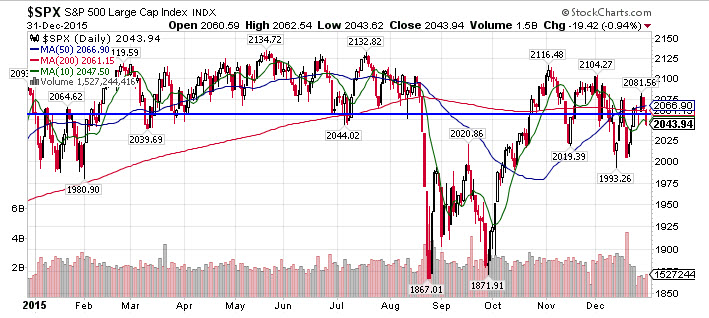With the beginning of a new year upon us, it is the perfect time to reflect on your trading over the past year, dig in to see what worked and fix what didn’t work, and look at how to improve your trading in the new year.
As we all know, last year was a very difficult one; the market moves of 2015 were sharp, quick, and made our heads spin. While you can try to understand why the markets behaved that way, it will likely only explain a fraction of why you lost (and won) certain trades. What you really need to do is to look at how you reacted, how that affected your performance, and how you can find better solutions in the year ahead.
How to Improve Your Trading
Let’s look at the chart of the SPX 500 below, which finished 2015 down just under 1%. That final reading does not tell the entire story of the past 52 weeks, when volatility was the name of the game. When I look back on the previous trading year,  I don’t really focus on the charts. Instead, I run an analysis on my mentality, which really opens my eyes to what happened. Trading is only half the work; mental preparation makes up the other half.
I don’t really focus on the charts. Instead, I run an analysis on my mentality, which really opens my eyes to what happened. Trading is only half the work; mental preparation makes up the other half.
Below is a partial list of the questions I run through each year. Feel free to use them to start your own analysis. (One caveat before you get started – if you want to improve your performance this year: Be honest with yourself when you do this post mortem.)
- What were your best trades of the year? What made them so good? Was it the results? Timing? Luck?
- What were your worst trades of the year? Did you get unlucky? Did you sway from your disciplined approach?
- Did you end the year on the plus or minus side? Is there something you need to change in your process to make 2016 even better?
- Did you commit to continuing education? Are you smarter than you were a year ago? Did you improve your mental approach to trading? Read some books? Attend classes or webinars? Hire a coach?
- Take a look at different points in time during the year and how you responded. Did you panic? Were you calm? Did you take advantage of emotional extremes?
- Where is the Fed’s policy right now? (I look at this every year and adjust my strategy if policy changes during the year. I will make a commitment to the market if they are currently supporting risk assets.)
Do you keep a journal? If so, you can easily find the answers to some of the trades that caused you to stumble. I would highly recommend writing your daily thoughts in a trading journal – it is one of the most powerful tools in my toolkit.
You can run through the above questions on a regular basis – not just once a year – which you may find very helpful. When you get so immersed in the action of the market day, you tend to forget your game plan and how you got to where you are. Taking a step back allows you to think rather than do, hit the reset button and get a fresh start.
Once again, be honest, because if you aren’t, then you are only cheating yourself, making the same mistakes and probably going insane. As Einstein once said, “Insanity is doing the same thing over and over expecting different results.”
Now that you have an idea of how to improve your trading, here’s to a very successful 2016!
Copyright: andresr / 123RF Stock Photo



















